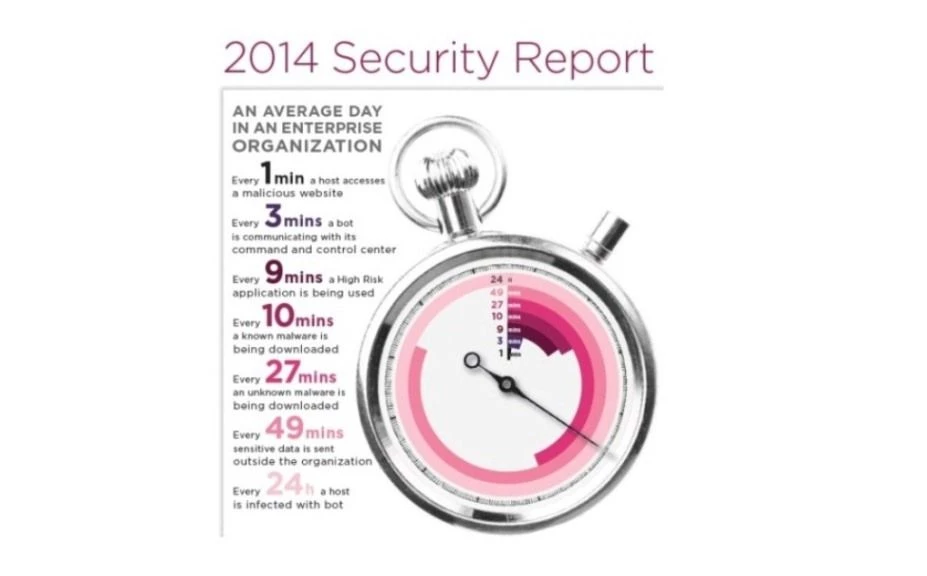
Partner Article
Report shows exponential increase in new and unknown malware on enterprise networks
Check Point has issued its 2014 Security Report, its second annual report uncovering the major security events that occurred and impacted organisations across the world in 2013. The report is based on analysis of monitored security events from over 10,000 organisations worldwide, across a range of industry sectors. It shows the network security events that actually occurred within firms during 2013, and the security risks that companies are exposed to.
Key findings include:
Malware activity increased in speed and quantity
Malicious software was downloaded every ten minutes in 84% of the organisations under analysis. Last year, 58% of organisations experienced users downloading malware every two hours or less, compared with just 14% in 2012.
’Unknown’ malware grows
Smarter and more resilient malware emerged in 2013. 33% of organisations downloaded at least one infected file with unknown malware between June and December 2013. Of those infected file types, 35% were PDFs. New tools called ‘crypters’ enabled malware writers to bypass detection by anti-malware software, so that organisations were hit by 2 pieces of unknown malware every hour – one every 27 minutes.
Bot infestations
Bot infections continued to grow, with a host infected by a bot every 24 hours. In 2013, at least one bot was detected in 73% of organisations, an increase from 63% in 2012. Organisations also struggled with containing bots, as 77% of bots are active for more than four weeks. Bots communicated with their ‘Command & Control’ every three minutes.
Data losses mount
Check Point found that 88% of organisations had experienced at least one potential data loss event, up from 54% in 2012. In fact, in 33% of the financial institutions surveyed by Check Point, credit card information was sent outside of the organisation while 25% of healthcare and insurance institutions sent HIPAA-protected information.
Risky applications result in risky business
Use of high risk applications continued to be on the rise in 2013, with torrents, anonymisers, peer-to-peer (P2P) file sharing applications being used every nine minutes on an average day. P2P file sharing usage increased to 75% in 2013 from 61% of firms in 2012. Also, 56% of firms ran anonymizer proxy applications in 2013, up from 43% in 2012.
“Our 2014 Security Report peeled back more layers to reveal the infiltration and sophistication of malware in 2013. We found organisations at more risk with both the new threats of today, as well as the old threats identified in last year’s Security Report,” said Amnon Bar-Lev, president of Check Point Software Technologies. “It is clear that organisations need more understanding of, and protections for the threats that endanger their networks, with security based on real-time threat intelligence.”
The Check Point 2014 Security Report is based on collaborative research from Check Point Security Checkup assessments, Check Point Threat Emulation sensors, Check Point ThreatCloud and Endpoint Security reports, and includes in-depth analysis of 200,000+ hours of monitored network traffic from 996 organisations worldwide and over 9,000 security gateways deployed across various industries.
This was posted in Bdaily's Members' News section by Check Point .
Enjoy the read? Get Bdaily delivered.
Sign up to receive our popular morning National email for free.








 How to make your growth strategy deliver in 2026
How to make your growth strategy deliver in 2026
 Powering a new wave of regional screen indies
Powering a new wave of regional screen indies
 A new year and a new outlook for property scene
A new year and a new outlook for property scene
 Zero per cent - but maximum brand exposure
Zero per cent - but maximum brand exposure
 We don’t talk about money stress enough
We don’t talk about money stress enough
 A year of resilience, growth and collaboration
A year of resilience, growth and collaboration
 Apprenticeships: Lower standards risk safety
Apprenticeships: Lower standards risk safety
 Keeping it reel: Creating video in an authenticity era
Keeping it reel: Creating video in an authenticity era
 Budget: Creating a more vibrant market economy
Budget: Creating a more vibrant market economy
 Celebrating excellence and community support
Celebrating excellence and community support
 The value of nurturing homegrown innovation
The value of nurturing homegrown innovation
 A dynamic, fair and innovative economy
A dynamic, fair and innovative economy